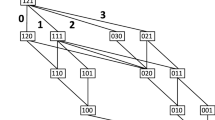Abstract
Using symmetry to determine Hamiltonian matrix elements for quantum systems with finite group symmetry is a special case of obtaining group-generated irreducible tensorial matrices. A group-generated irreducible tensorial matrix transforms irreducibly under the group and is a linear combination of group transformations on a reference matrix. The reference matrix elements may be appropriate integrals or parameters. The methods of normalized irreducible tensorial matrices (NITM) are employed to express elements of the generated matrix in terms of those of the reference matrix without performing the actual transformations. Only NTTM components of the reference matrix with the same transformation properties as the group-generated matrix will contribute to its elements. The elements of invariant symmetry-generated matrices are proportional to simple averages of certain elements of the reference matrix. This relation is substantially more efficient than previous techniques for evaluating matrix elements of octahedral and tetragonal d-type ligand-field Hamiltonians.
Similar content being viewed by others
References
M.L. Ellzey, Jr., Int. J. Quant. Chem. 41 (1992) 653.
M.L. Ellzey, Jr., J. Math. Chem. 8 (1991) 333.
M.L. Ellzey, Jr., Int. J. Quant. Chem. 40 (1991) 347.
L.C. Biedenharn and J.D. Louck,Angular Momentum in Quantum Physics: Theory and Applications, Encyclopedia of Mathematics and its Applications, Vol. 8, Ser. ed. G.-C. Rota (Addison-Wesley, New York, 1981).
G. Racah, Phys. Rev. 63 (1943) 367.
M. Kibler and G. Grenet, Int. J. Quant. Chem. 28 (1985) 213.
M. Kibler, J. Math. Phys. 21 (1980) 422.
M. Kibler, Int. J. Quant. Chem. 3 (1969) 795.
M. Kibler, J. Mol. Spectrosc. 26 (1968) 111.
J.S. Griffith,The Theory of Transition Metallons (Cambridge, 1961).
M.L. Ellzey, Jr., Int. J. Quant. Chem. 7 (1973) 253.
Ref. [10] p. 226.
M.L. Ellzey, Jr., J. Chem. Inf. Comp. Sci. 34 (1994) 259.
D.J. Klein, J. Math. Phys. 25 (1984) 200.
M. Hamermesh,Group Theory And Its Applications To Physical Problems (Addison-Wesley, New York, 1962).
J.S. Griffith, Mol. Phys. 3 (1960) 258.
J.S. Griffith,The Irreducible Tensor Method for Molecular Symmetry Groups (Prentice-Hall, Englewood Cliffs, NJ, 1962).
D.E. Littlewood,The Theory of Group Characters (Oxford University Press: Oxford, UK, 1950).
Author information
Authors and Affiliations
Rights and permissions
About this article
Cite this article
Ellzey, M.L. Elements of irreducible tensorial matrices generated by finite groups with applications to ligand field Hamiltonians. J Math Chem 19, 1–13 (1996). https://doi.org/10.1007/BF01165126
Received:
Revised:
Issue Date:
DOI: https://doi.org/10.1007/BF01165126




